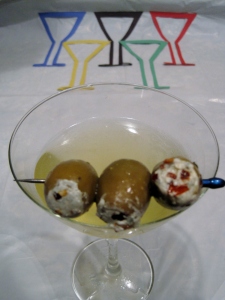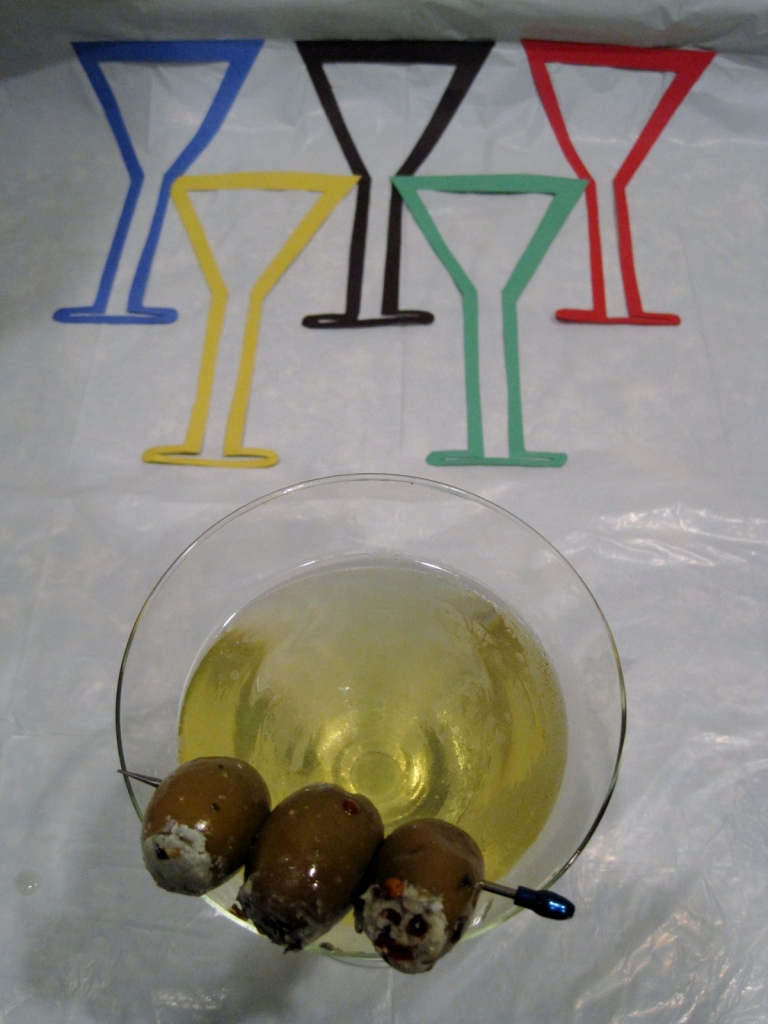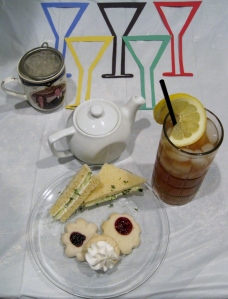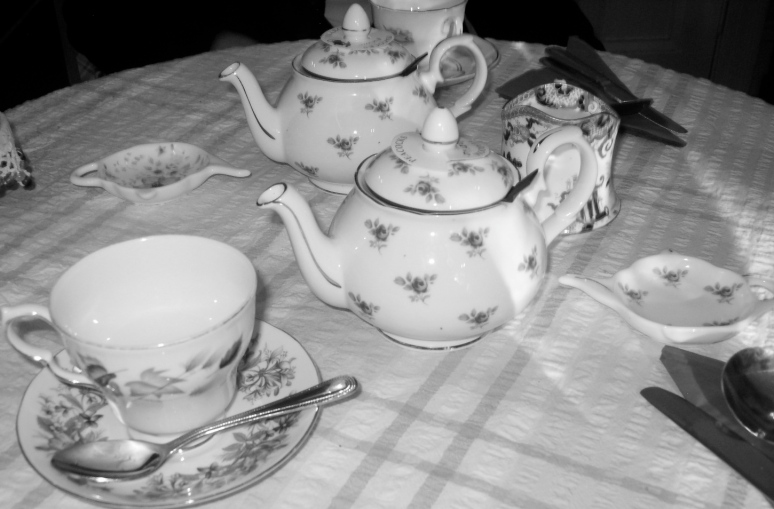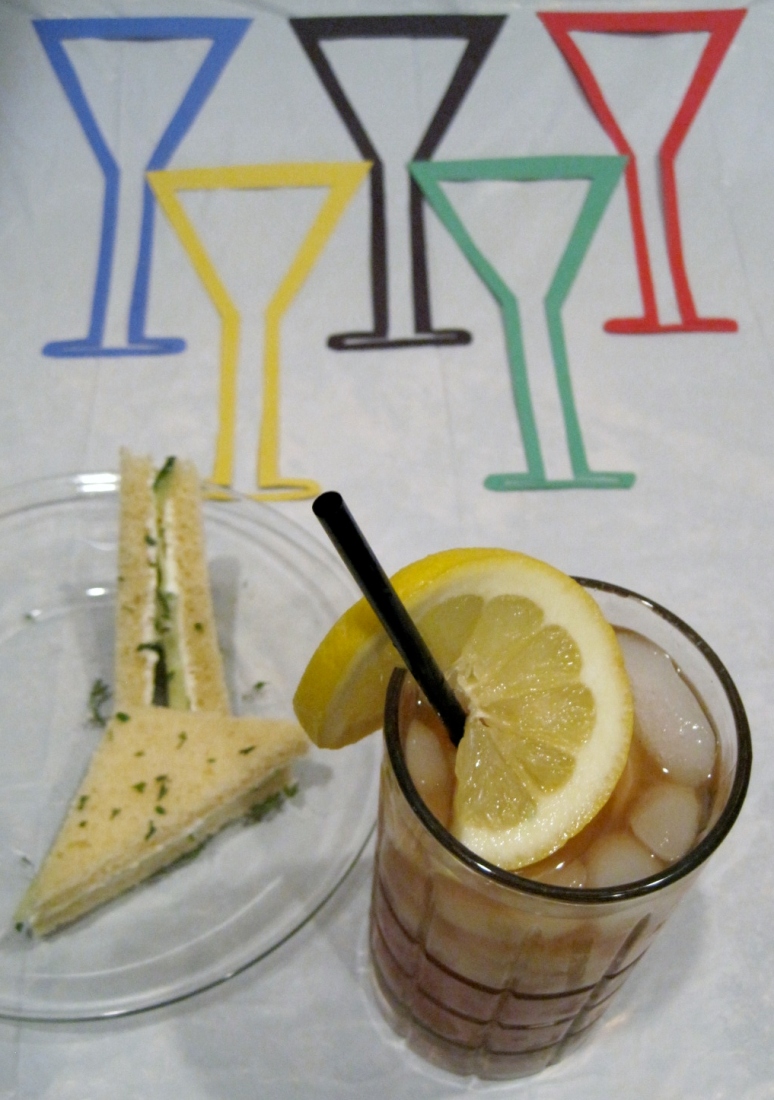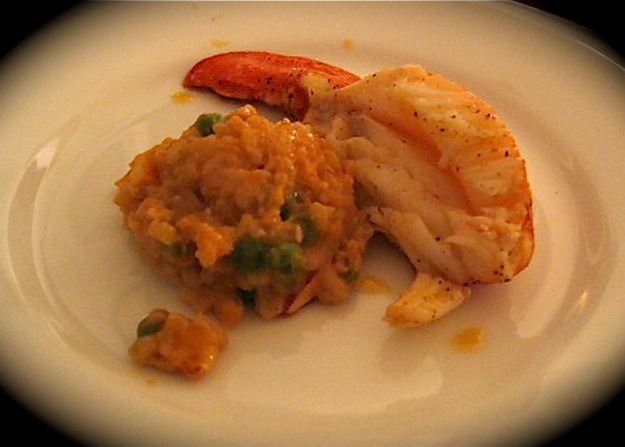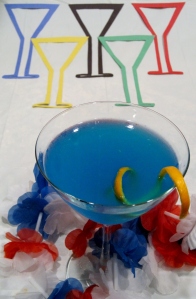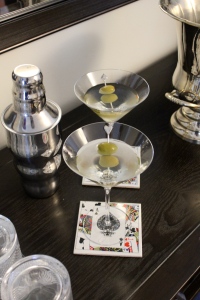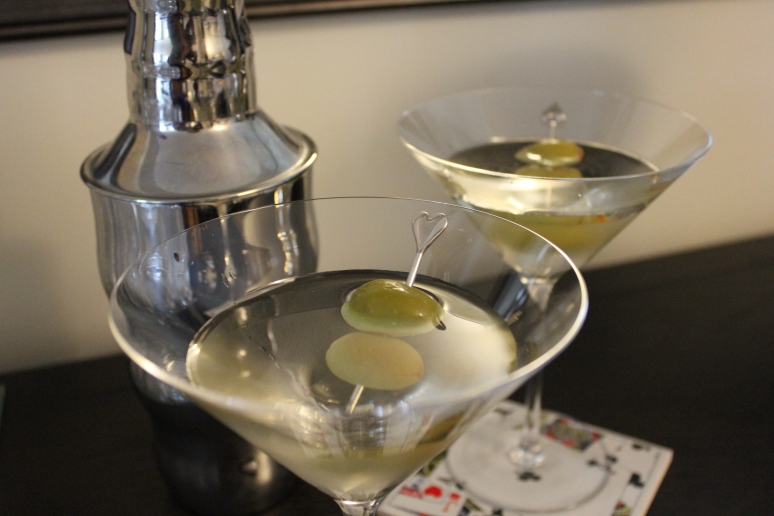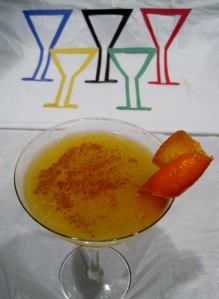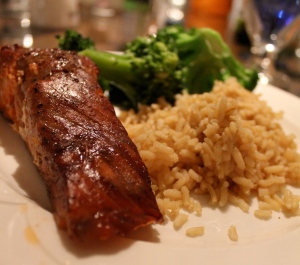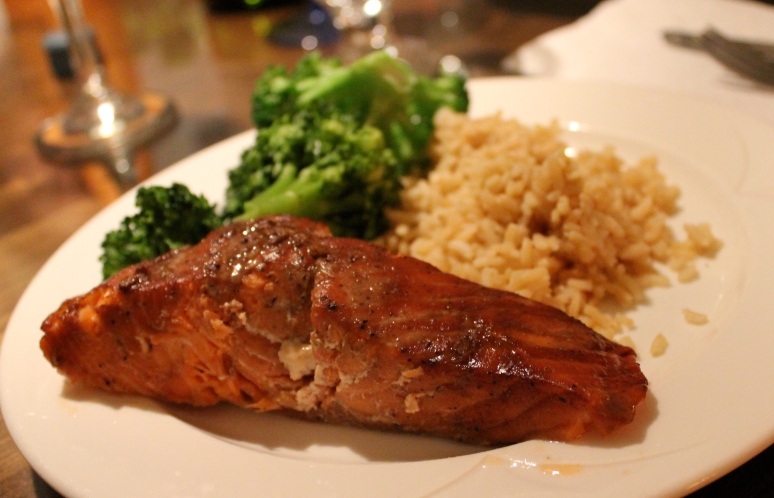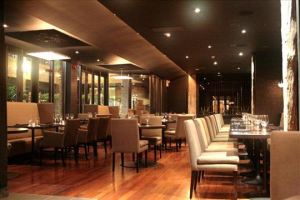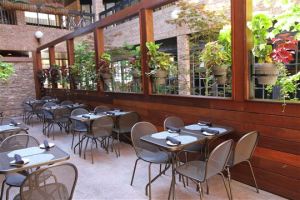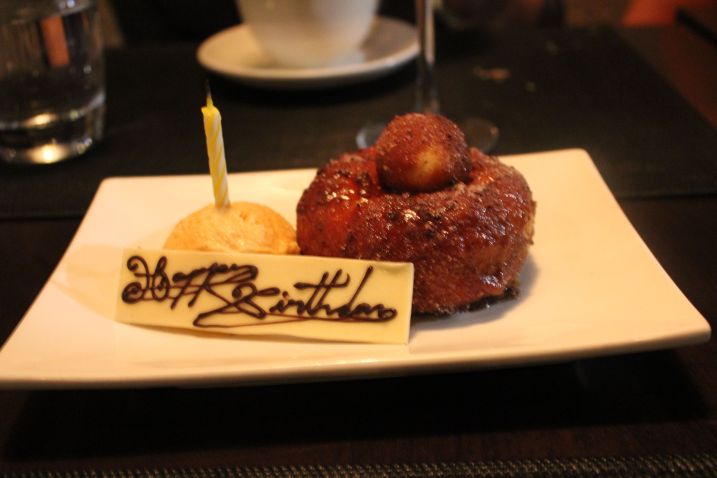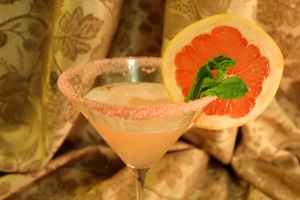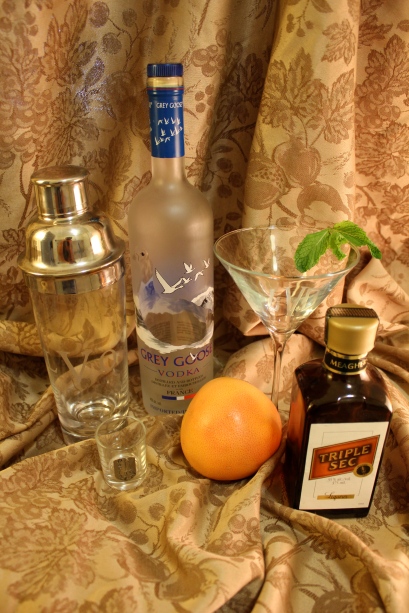XXX Martini
As we bid adieu to Baron de Coubertin’s 30th games, nothing says triple X better than something hot and dirty! Be naughty and enjoy a stiff one tonight: take a crack at the Refined Chef’s filthy, fiery martini!
London Dry Gin
Brine from a jar of olives
Brine from a jar of hot pickled peppers
Blue cheese-stuffed olives*
In a mixing glass, filled with ice, add 2 parts London Dry Gin, 1 part olive brine, and ½ part hot pepper brine. Shake and strain into a chilled cocktail glass. Garnish with blue cheese-stuffed olives.
*NB: You can purchase blue cheese-stuffed olives, but I prefer to make my own. I use large, pitted Spanish olives and then stuff them with a premium blue cheese, which I have rolled in crushed red pepper flakes. The creaminess of the blue cheese complements the saltiness of the brine in the cocktail, and the crushed red pepper adds a little extra spanking to the XXX. If it makes you feel better, come up with a safety word for you and your drinking partner, in case the heat is too much! Miss O.
London Iced Tea
Afternoon tea, a long-standing British tradition, often involves dainty cucumber sandwiches, scones, and tasty miniature pastries. Well, this ain’t your nana’s tea; savour the Refined Chef’s irreverent interpretation of English heritage and sip on a London Iced Tea!
Iced Earl Grey Tea
London Dry Gin
Orange Liqueur
Lemon slice
Fill a Collins glass with ice. Add 2 parts iced* Earl Grey tea, 2 parts London dry gin, and 1.5 parts premium orange liqueur. Stir. Add a straw and garnish with a lemon slice. Cheers, and don’t forget to lift your little finger!
How to make ICED Earl Grey Tea (Yes, I KNOW, it’s sacrilege!)
In a preheated teapot, add 1 teaspoon of Earl Grey tea leaves for each 0.5 cup (100 mL) of water. Bring fresh, filtered water to a rolling boil, and pour IMMEDIATELY onto the tea. The teapot should be only HALF full… or half empty, depending on your frame of mind. Cover with a lid. Steep the tea for 4 minutes. Fill the rest of the teapot with ice; then, strain the tea over a glass of ice. (For the cocktail, I strained the tea, but didn’t strain it over a glass of ice, as it would be over ice with the gin and orange liqueur.)
If you only have tea bags, I would use 1 tea bag for a cup of tea (about 8oz/200 mL), and fill the cup half way with boiling water. Steep the bag for 4 minutes; then, fill the rest of the cup (with the tea bag still in it!) with ice. Pour over a glass of ice. Miss O.
Imperial Kobe Beef vs. Wild Rose Beef
Imperial Kobe Beef versus Wild Rose Beef
The age-old pursuit of finding the best tasting beef has driven chefs and foodies to travel, import, and explore the world over. While many think high cost must have a direct link to better quality, this theory usually does play true in the food world. For the most part, you do get what you pay for in terms of quality, selection, and creativity. I set out to conduct a blind taste test with a small group of food enthusiasts to settle the score. In the fight for best beef I selected two obvious opponents, Imperial Japanese Kobe Beef and Wild Rose Alberta Beef. Using strip loins that share similar thickness and ageing I set out to settle the score in black tie style.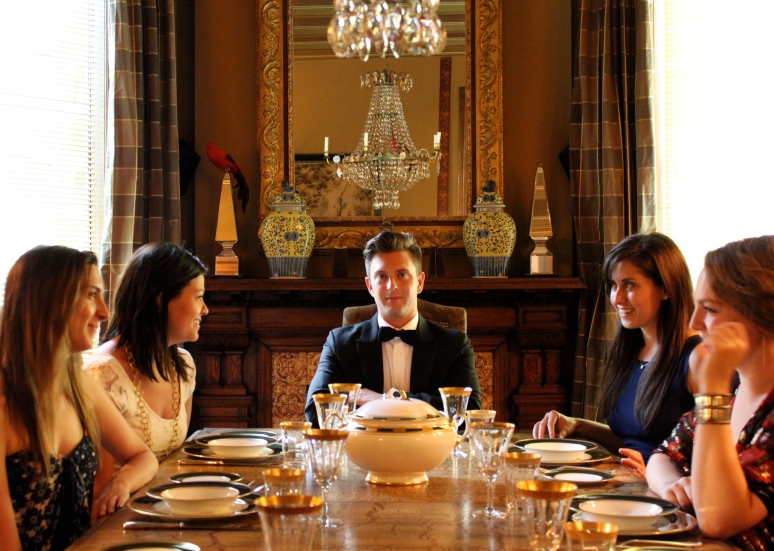
 Every Canadian knows one of Alberta’s greatest exports and contribution to the world is its beef, or if they don’t, they should. There are distinctly different practices used to raise cattle all over the globe. In Alberta, calves once weaned from their mothers are back-lotted, a practice that refers to a young calf given a forage diet in pasture. This results in a happy mobile ‘free range’ cow, low feeding cost, and an incredible rate of natural growth. By allowing the animal to move around naturally the meat develops a richer flavor. Once the cow reaches the desired weight they are moved to the finishing stage in the feedlot. The animal’s diet is drastically changed to almost exclusively grain to jump start growth and develop the best possible marbling. Many feedlots outside of Alberta, like in the U.S., finish cattle on corn. Corn is a less expensive readily available feed that produces a flavorless and yellowish cut of meat.
Every Canadian knows one of Alberta’s greatest exports and contribution to the world is its beef, or if they don’t, they should. There are distinctly different practices used to raise cattle all over the globe. In Alberta, calves once weaned from their mothers are back-lotted, a practice that refers to a young calf given a forage diet in pasture. This results in a happy mobile ‘free range’ cow, low feeding cost, and an incredible rate of natural growth. By allowing the animal to move around naturally the meat develops a richer flavor. Once the cow reaches the desired weight they are moved to the finishing stage in the feedlot. The animal’s diet is drastically changed to almost exclusively grain to jump start growth and develop the best possible marbling. Many feedlots outside of Alberta, like in the U.S., finish cattle on corn. Corn is a less expensive readily available feed that produces a flavorless and yellowish cut of meat.
Over 90 percent of beef produced in Alberta achieves A, AA, AAA or higher grade. This fact is absolutely astonishing and a testament to the developing farming practices in the province. In Canada, an AAA Alberta strip loin costs approximately $19 per pound from the local butcher.
 Kobe cattle refer to the specific breed Wagyu, raised in Hyogo, Japan. Kobe beef is strictly regulated from its lineage, its feed, where it’s raised, plus how and where it is slaughtered. These tight restrictions and practices result in an incredibly well-marbled and flavored meat. Farmers in Hyogo, Japan feed their cattle strictly grain and the animals are brushed on a regular base to settle the fur. Due to the lack of grazing land in the valley the cattle are unable to get proper exercise, which has changed the genetic characteristics in the cattle, thus creating an extremely well marbled animal. Also, because of the lack of exercise, the cows must be massaged to prevent soreness and loss of appetite. Believing that soft skin produces more tender meat, workers also rub Wagyu cows with sake or Japanese rice wine. As champagne must come from Champagne, France to be referred to as champagne, Kobe beef must come from Hyogo, Japan. Due to the restrictions, plus tight import laws, getting your hands on actual Kobe is almost impossible in North America and if you do, it is extremely expensive unless you have the right connections in the food industry.
Kobe cattle refer to the specific breed Wagyu, raised in Hyogo, Japan. Kobe beef is strictly regulated from its lineage, its feed, where it’s raised, plus how and where it is slaughtered. These tight restrictions and practices result in an incredibly well-marbled and flavored meat. Farmers in Hyogo, Japan feed their cattle strictly grain and the animals are brushed on a regular base to settle the fur. Due to the lack of grazing land in the valley the cattle are unable to get proper exercise, which has changed the genetic characteristics in the cattle, thus creating an extremely well marbled animal. Also, because of the lack of exercise, the cows must be massaged to prevent soreness and loss of appetite. Believing that soft skin produces more tender meat, workers also rub Wagyu cows with sake or Japanese rice wine. As champagne must come from Champagne, France to be referred to as champagne, Kobe beef must come from Hyogo, Japan. Due to the restrictions, plus tight import laws, getting your hands on actual Kobe is almost impossible in North America and if you do, it is extremely expensive unless you have the right connections in the food industry.
Incredible practices and isolation have resulted in this unique animal, unlike any other cattle, producing rich, well-marbled beef higher in grade then AAA or prime. These particular strip loin steaks came at the extravagant coast of $76 per pound, plus a few personal favors.
We began the black tie evening with cocktails, discussing the facts of each animal and the different practices used in raising them. We talked about that the way the meat may look and the possible differences in fat content. Once we were well into conversation and cocktails the anticipation grew to a tipping point. I served fresh Atlantic lobster risotto to start my guests’ palates. The risotto was rich in texture each adored by a piece of lobster claw or tail. Accompanied by bottles of Oyster Bay Sauvignon Blanc from New Zealand, it was an incredible tease that almost had every one forgetting about the main event.
The steaks had been set on the counter in the kitchen seasoned with simple salt and pepper warming to room temperature and the grill heating. I excused myself to complete the meal knowing the blind taste test was about to begin. Each steak was grilled to perfection medium rare so that there would be no difference in the cooking process. Then the steaks were sliced on different cutting boards to prevent cross contamination of taste. Each plate had Kobe beef placed on the left A and Alberta beef on the right B. Dividing the main course was a vegetable medley and spring mixed potatoes, both abundant in colour and flavor. With no one other then I knowing which strip loin was which, the plates were taken into the dining room and put before my eager guest judges.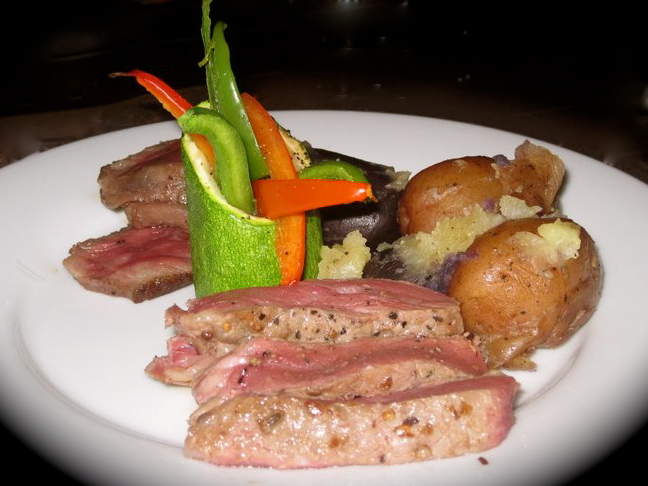
Advising Beef A is on to the left and Beef B to the right, we began to enjoy our meal appreciating each bite, our palates exploring the differences between the two. I paired the beef with a bold Wolf Blass Gold Label Cabernet Sauvignon from Australia. The wine was selected deliberately to draw out the natural rich flavors in the beef. Many made the observation that A, the Kobe, was very well-marbled and had a rich subtle flavor with hints of grain, grass, and almonds. B, the Alberta product was said to be more vibrant in taste, less marbled with hints of grass, sweet sugar cane, and lemon zest. The conversation and wine continued throughout the dining experience until everyone was ready to cast their vote.
The verdict was one for A and six for B. Alberta beef had won this contest almost unanimously. Our incredible evening came to a close with a certain and clear answer. Chefs and farmers all over Canada can be proud to produce and serve Alberta beef, the best in the world, which comes at a fraction of the price of Kobe. Undoubtedly, my guest had a night they were thrilled to be a part of and soon won’t forget. Laine Valin
This slideshow requires JavaScript.
G8r AiD
G8r AiD
Was 3D TV, specifically, invented with diving, swimming, and beach volleyball in mind? After the action at the London aquatics zone over the weekend, all I can ask is: Michael, who? A toast to the man responsible for Team USA’s first gold medal in London: Gator alumnus, Ryan Lochte, whose abs have graced many a girl’s dreams and the cover of Vogue! G8r AiD: a panacea for your pool-side parties.
Blue Curaçao
White Rum
Freshly squeezed lime juice
Orange twist
Fill a shaker with ice. Add 2 parts blue curaçao, 2 parts white rum, and 1 part freshly squeezed lime juice. Shake and strain into a chilled martini glass. Garnish with an orange twist, naturally! Pull up a chaise longue, pull on your sunglasses and imagine your nation’s swim team, sipping on G8r Aid, at your next pool party… oh, Jeah! Miss O.
This slideshow requires JavaScript.
The Classic Gin Martini
James Bond and I share a few similarities we both pull off a tux flawlessly and our drink of choice is the classic gin martini! Bombay sapphire gin, dry, “shaken not stirred”, and just a dash of olive juice. This drink is not for the faint of heart and packs a punch but when sipped in London this Olympics or just watching the games at home you’ll be doing it in British style!
-2 oz Bombay gin
-1 teaspoon olive juice
-a splash of dry martini
Combine all ingredients in a martini shaker full of ice. Shake well until the shaker is frosted, strain into a martini glass and garnish with 2 large olives. Sip and enjoy! Laine Valin
.
.
OPENING CEREMONY
OPENING CEREMONY
I could barely contain my excitement, when the Refined Chef announced our new theme: a quadrennial sporting event, in which most countries participate, hosted by London, one of our favourite cities. Could it be time again for the Bar-lympics? YOU know… those competitive drinking games, originating in the ancient city of Barlympia, situated halfway between de Baa and de Lew. Drinking IS a sport, right? I’m fairly certain that all of the Refined Chef contributors are medalists and representatives of their nations’ drinking teams… Just in case he meant that OTHER global sporting event, practise our twist (double full in, full out, OF COURSE!) on the classic Olympic cocktail, our Opening Ceremony. Let the games begin!
Brandy,Orange Liqueur, Freshly Squeezed Orange Juice, Orange Zest
Ground Nutmeg, Match(es)
Fill a shaker with ice. Add 1 part premium orange liqueur, 2 parts of brandy (I used a VSOP for its smooth taste – no need to break out the XO for a mixed drink!), and 2 parts of freshly squeezed orange juice. Shake and strain into a chilled martini glass. Add a dash of nutmeg. Flame* an orange peel over the drink, rub the peel around the rim, and garnish the OC with the orange twist. Let’s face it – drinking is a perennial event for the Refined Chef contributors. We don’t recommend attempting strenuous activity after imbibing an Opening Ceremony.
*How to Flame an Orange Peel
Peel a strip off an orange, about the length of your forefinger; a bit of pith on the zest is ok – it makes it easier to squeeze. Make sure there’s nothing above your cocktail that might be set alight. Light your flame (I prefer a match to a lighter), and hold it above your cocktail (if you hold 3 fingers together on their sides above the rim, you have the right height). Hold the orange peel with the zest side closest to the flame (not too close that you blacken the peel; you want the peel about the same distance from the match that the match is from the cocktail). Squeeze the peel over the lit match. Enjoy the pyrotechnics of your very own torch, before you douse it in the cauldron. Practise makes perfect, or you may get to know the local fire brigade – it’s a win-win situation! Miss O.
This slideshow requires JavaScript.
Teriyaki Barbecued Salmon
This summer why not capitalize on the Seasonal Wild Salmon, as this season is the only time of year that you can get fresh, not frozen wild salmon! Full of flavor, when compared with farmed salmon, and jam-packed full of nutrition, this recipe will have you draping the salmon in sweet teriyaki and spending almost no time in the kitchen!
Having guests over is what I do. Family, friends, and friends of friends, but my secret to enjoying company is to keep it simple. Properly preparing my ‘mise en plus’ or having everything ready to cook, so that when guests arrive I’m ready to enjoy their company! Begin by stopping in at your favorite fresh seafood supplier. This could be a local butcher, specialty food store, grocery store, of even better your local community market. The best way to order salmon is to ask for 6-8oz individually cut, skin on, salmon fillets, centre cut. You have just given them the absolute specific instructions that are universal and will assure you get what you want! 6-8 oz is a good portion size for adults, skin on keeps the fish together while grilling; and centre cut refers to the centre of the fish so that all pieces are uniform in size. (Insiders information; in the City of Toronto and many other non-coastal cities seafood suppliers are closed on Sundays and holidays, which means the seafood supply is temporarily interrupted. The best day to get fresh fish as a result is Tuesday to Saturday. Purchase teriyaki sauce in the grocery store’s BBQ sauce isle.
Once you have the individually cut salmon fillets you can begin marinating for the day in Ziploc bags. Pour enough Teriyaki sauce to coat each fillet. When your guests arrive you can heat up the grill. There are three rules to grilling that must be followed:
-Use vegetable oil to grease the grill generously to prevent sticking.
-Only ever touch or move your fish, chicken, or steak 4 times!
Men in particular will have a problem with this rule, but constantly moving the meat will pull the product apart and will prevent you from achieving the perfect diamond grill marks. Don’t overcook the food, if your grill is properly heated a one-inch steak will take 3 to 4 minutes each side to reach medium rare. On the same note salmon should be served medium or medium well to keep it moist and full of flavour.
Using tongs remove the teriyaki marinated fish out of the Ziplocs bag and place skin side down on the hot, well oiled grill, starting at the back place them closer to make sure there’s room for all of them. Close the lid and let cook for 2 -3 minutes, then flip over carefully trying to keep the fillet in once piece! Grill for 2-3 minutes and rotate each piece 40 degrees cooking for another 1-2 minutes. By following these instructions you’ll get a medium cooked salmon fillet with perfect grill marks! Add some fresh summer vegetables, rice or potatoes! Your house will stay cool and you’ll get to enjoy your company! Laine Valin
Earth Restaurant
A truly local Canadian dining experience can be discovered in Toronto’s Rosedale neighborhood. Identified simply as Earth, this discriminate restaurant is branded by its slogan ‘think global, eat local.’ Simply, by actively seeking open dialogue with local farmers and producers, the resulting superb culinary experience presented at Earth, remains undisputed. Expect five-star luxury dining
Using the ‘think global, eat local’ concept, the chef has set his staff to creating a menu that varies with the seasons, and incorporates quality seasonal fare produced within a 100-mile radius of our own region. Many chefs would find such restrictions, well just that, restricting. However, the team at Earth uses this premise as an opportunity to be creative and innovative, utilizing fresh greens grown in the summer, pumpkin and squash in the fall, and royal red beats in the dead of winter. The cooking team’s ingenuity is quite astonishing.
From experience, I can highly recommend any one of the appetizers, soups, and salads in which to begin your dining experience, but I have a soft spot for the fresh PEI shucked oysters, with a dash of horseradish, lemon, and sauces made in-house. A dozen or so cooled, smooth and raw, accompanied by a glass of Canadian sparkling wine to enhance the experience, is a perfect warm up for your palate. Seasonal soup, again made fresh in- house, range from Atlantic Lobster Bisque to fresh Butternut squash, can vary on the menu daily depending on what fresh ingredients at the morning market appeal to the chef.

Many people will ask, “What is Canadian cuisine?” My answer is always, that which is unique to our land, the fish, foul, wild game that our country was literally built on. With that in mind the menu has developed in a way everyone can enjoy.
The entrees at Earth feature fresh vegetables, potatoes, and uniquely Canadian game. The culinary team perfectly makes use of Canadian elk, venison, duck, regional fresh-fish and Atlantic seafood, in addition to locally farmed poultry and beef. The farmers in Wellington County provide Earth’s beef, particularly their incredible grilled beef tenderloin, juicy and moist, cooked to perfection without exception. Dinner at this dining establishment could not be more Canadian than savoring a rare seared duck breast or fresh Ontario rainbow trout. For desert you can’t go wrong with a ground cherry donut, served hot out of the fryer, with Earth’s handmade ice cream.
The wine list boasts an impressive selection, which again remains true to the term ‘local’. Lynne Stimpson has personally selected over 30 wines from Ontario and British Columbia, as well as a select few ‘global’ choices. By working directly with regional vineyards, Earth staff has also had a hand in creating signature wines featured only on its wine list. Ontario’s Cave Springs Winery provides an incredible Chardonnay made specifically for the restaurant.
My affection for Earth only grows with its list of signature cocktails, made with liquor flavor-infused on-site. For example, the blueberry vodka is with real Ontario blueberries and whiskeys are smoked with Canadian back bacon right on the premise. Earth is a mixologist’s dream and a bartender’s playpen, with these house-infused liquors becoming the elixir for the people behind the bar demonstrating true expression and artistry. By being creative with spirits, Earth’s signature cocktails are unique to them. I say try one of everything on the creative cocktail menu, but do it responsibly, like one or two a day over the course of this summer!
.
.
.
In addition to delicious food and drink, the service at Earth is amazing. It is like watching a well-choreographed dance, with every move timed perfectly, and refined wait-staff anticipating each customer’s desire and need As a tribute to Ms. Stimpson, the ‘service choreographer’ Earth offers a wonderful experience each time you pass through its doors, whether you are out for a mid-week meal, hosting an exclusive VIP event in its spacious 16-person private dining room, or sipping a cocktail on one of the restaurant’s two patios, be assured it will be a flawlessly executed event.
Laine Valin
This slideshow requires JavaScript.
The Pink Can-can
When thinking of France thoughts of a romantic backdrop, love scenes and happily ever after most often comes to mind. Rarely would thoughts travel to the seedy, red light Quartier Pigalle in Pairs, or the dark, unromantic pleasures enjoyed there over the past several centuries.
The seductive crown jewel of La Pigalle district is undoubtedly the Moulin Rouge, the world-famous cabaret that has offered inspiration to poets, artists, along with satisfying the secret desires of men, young and old. Opening its doors in 1889, Moulin Rouge revolutionized erotic dance in Europe with its most famed re-creation of the Cancan, a dance originally introduced in the working-class ballrooms. Moulin Rouge “The Red Windmill” became synonymous with luxury and extravagant “night life” and was a particular hit with the gentlemen elite of Pairs.
In 1890, HRH the Price of Wales, later to be King Edward VII, having crossed the English Channel entered France from England unnoticed. Upon making his way to Pairs, in secrecy and discretion he secured a private table at the famous Moulin Rouge. La Goulue, a famed dancer synonymous with the Cancan, the Moulin Rouge, the toast of Paris and the highest paid entertainer of her day, was high kicking her legs when the Prince entered the cabaret, yet she recognized him instantly and yelled out “Hey, Wales. Champagne’s on you!”
What was the dance this girl and her entourage were performing, which had the Prince so enthralled? Why, it was the Cancan, a high-energy, seductive dance, not exclusive to Moulin Rouge but made notable by its high-caliber dancers. Viewed at the time as a risqué erotic display, the cancan is a dance of high kicks and loud shrieks, revealing only what a woman chooses and upper-class men opening their wallets wide in an effort to see more.
The Pink Can-can
2 oz Grey Goose Vodka
1/2 oz Triple Sec
2 oz Grapefruit juice
1/2 oz Pineapple juice
A grapefruit slice and pink sugar for the rim
Begin your sweet seductive dance by filling your martini shaker with ice. Combine all ingredients. Shake well until the shaker begins to frost or as I tell my bartender’s ‘break the ice’. Rim your favorite martini glass with the grapefruit slice and dip into the pink sugar. This sweet and bitter rim is an all too obvious metaphor for the bittersweet love affair between gentlemen and their courtesans. Strain the chilled cocktail into the glass and serve.
This slideshow requires JavaScript.
LA VIE EN ROSE
Salut, nos amis! Perhaps, la reine, Marie Antoinette, would not have lost her head, had she uttered, “Let them drink cocktails!” instead of “Let them eat cake.” However, the têtes royales DID roll and the streets were coloured with blood. Vive la Révolution and take a crack at making our version of the oft-varied martini français, or French Martini: La Vie en Rose – sweet, yet potent, like the great Édith Piaf, herself.
Vodka
Black Raspberry Liqueur
Fresh Pineapple Juice
Fresh black raspberries or blackberries
Fill a shaker with ice. Add 2 parts vodka (Grey Goose, if you want to stay true to France), 1 part black raspberry liqueur (Chambord, it’s French, naturellement), and 3 parts fresh pineapple juice. Shake – VIGOUROUSLY!! (About 10-15 times, or til frost forms on the outside of the shaker.) Strain into a chilled martini glass – you should have a nice head of pineapple foamy goodness if you followed instructions to shake – VIGOUROUSLY! Garnish with fresh black raspberries or blackberries on a cocktail skewer. Grab a baguette, don a beret, and indulge in life’s rosy hue: bonne soif et santé!
Miss. O.
This slideshow requires JavaScript.
-
Recent Posts
Archives
Categories
Meta

